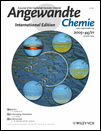Intermolecular Tandem Pd-Catalyzed Cross-Coupling/[4+4] and [4+2] Cycloadditions: A One-Pot, Five-Component Assembly of Bicyclo[6.4.0]dodecanes†
Phil Ho Lee Prof. Dr.
Department of Chemistry, Kangwon National University, Chunchon 200-701, Republic of Korea, Fax: (+82) 33-253-7582
Search for more papers by this authorKooyeon Lee Dr.
Department of Chemistry, Kangwon National University, Chunchon 200-701, Republic of Korea, Fax: (+82) 33-253-7582
Search for more papers by this authorPhil Ho Lee Prof. Dr.
Department of Chemistry, Kangwon National University, Chunchon 200-701, Republic of Korea, Fax: (+82) 33-253-7582
Search for more papers by this authorKooyeon Lee Dr.
Department of Chemistry, Kangwon National University, Chunchon 200-701, Republic of Korea, Fax: (+82) 33-253-7582
Search for more papers by this authorThis work was supported by the CMDS at KAIST and grant no. R02-2003-000-10023-0 of the Basic Research Program of the KOSEF. We thank Prof. Tom Livinghouse of Montana State University for proof-reading this manuscript.
Graphical Abstract
Starting from α-bromovinylarenes, propargyl bromides, and dienophiles, a novel intermolecular tandem Pd-catalyzed cross-coupling/[4+4] and [4+2] cycloaddition sequence provides bicyclo[6.4.0]dodecane derivatives by a rapid synthesis in one reaction vessel. Five components are assembled into one molecule in this process. EWG=electron-withdrawing group.
References
- 1N. Hall, Science 1994, 266, 32.
- 2
- 2aT.-L. Ho, Tandem Organic Reactions, Wiley-Interscience, New York, 1992;
- 2bT.-L. Ho, Tactics of Organic Synthesis, Wiley-Interscience, New York, 1994, p. 79;
- 2cL. F. Tietze, F. Haunert in Stimulating Concepts in Chemistry (Eds.: ), Wiley-VCH, Weinheim, 2000, p. 39.
10.1002/3527605746.ch4 Google Scholar
- 3
- 3aL. F. Tietze, U. Beifuss, Angew. Chem. 1993, 105, 137; Angew. Chem. Int. Ed. Engl. 1993, 32, 131;
- 3bR. A. Bunce, Tetrahedron 1995, 51, 13 103;
- 3cE. Negishi, C. Coperet, S. Ma, S.-H. Liou, F. Liu, Chem. Rev. 1996, 96, 365;
- 3dL. F. Tietze, Chem. Rev. 1996, 96, 115.
- 4
- 4aI. Ryu, H. Yamazaki, A. Ogawa, N. Kambe, N. Sonoda, J. Am. Chem. Soc. 1993, 115, 1187;
- 4bK. Tsuchii, M. Doi, T. Hirao, A. Ogawa, Angew. Chem. 2003, 115, 3614;
10.1002/ange.200250790 Google ScholarAngew. Chem. Int. Ed. 2003, 42, 3490.
- 5
- 5aT. Shono, I. Nishiguchi, M. Sasaki, J. Am. Chem. Soc. 1978, 100, 4314;
- 5bK. Takai, T. Ueda, N. Ikeda, T. Moriwake, J. Org. Chem. 1996, 61, 7990;
- 5cK. Takai, N. Matsukawa, A. Takahashi, T. Fujii, Angew. Chem. 1998, 110, 160;
10.1002/(SICI)1521-3757(19980116)110:1/2<160::AID-ANGE160>3.0.CO;2-7 Google ScholarAngew. Chem. Int. Ed. 1998, 37, 152;10.1002/(SICI)1521-3773(19980202)37:1/2<152::AID-ANIE152>3.0.CO;2-8 CAS Web of Science® Google Scholar
- 5dJ. Terao, K. Saito, S. Nii, N. Kambe, N. Sonoda, J. Am. Chem. Soc. 1998, 120, 11 822.
- 6
- 6aM. Lautens, W. T. Klute, Chem. Rev. 1996, 96, 49;
- 6bL. Yet, Chem. Rev. 2000, 100, 2963;
- 6cS.-I. Ikeda, Acc. Chem. Res. 2000, 33, 511;
- 6dJ. Montgomery, Acc. Chem. Res. 2000, 33, 467;
- 6eY. M. Dong, W. C. MacMillan, J. Am. Chem. Soc. 2001, 123, 2448;
- 6fP. A. Wender, G. G. Gamber, M. J. C. Scanio, Angew. Chem. 2001, 113, 4013;
10.1002/1521-3757(20011015)113:20<4013::AID-ANGE4013>3.0.CO;2-J Google ScholarAngew. Chem. Int. Ed. 2001, 40, 3895;10.1002/1521-3773(20011015)40:20<3895::AID-ANIE3895>3.0.CO;2-# CAS PubMed Web of Science® Google Scholar
- 6gS. Ikeda, J. Synth. Org. Chem. Jpn. 2001, 59, 960;
- 6hL. W. A. van Berkom, G. J. T. Kuster, F. Kalmoua, R. de Gelder, H. W. Scheeren, Tetrahedron Lett. 2003, 44, 5091;
- 6iK. Inanaga, K. Takasu, M. Ihara, J. Am. Chem. Soc. 2004, 126, 1352;
- 6jA. Ajamian, J. L. Gleason, Angew. Chem. 2004, 116, 3842;
10.1002/ange.200301727 Google ScholarAngew. Chem. Int. Ed. 2004, 43, 3754.
- 7
- 7aT. K. Devon, A. I. Scott, Handbook of Naturally Occurring Compounds, Vol. II, Academic Press, New York, 1972;
- 7bD. J. Faulkner, Nat. Prod. Rep. 1984, 1, 251, 551; D. J. Faulkner, Nat. Prod. Rep. 1986, 3, 1; D. J. Faulkner, Nat. Prod. Rep. 1987, 4, 539; D. J. Faulkner, Nat. Prod. Rep. 1988, 5, 613;
- 7cT. Oishi, Y. Ohtsuka, Studies in Natural Products Chemistry (Ed.: ), Elsevier, Amsterdam, 1989, p. 73;
- 7dC. J. Moody, Studies in Natural Products Chemistry (Ed.: ), Elsevier, Amsterdam, 1992, pp. 201–239.
- 8K. Lee, D. Seomoon, P. H. Lee, Angew. Chem. 2002, 114, 4057;
Angew. Chem. Int. Ed. 2002, 41, 3901.
10.1002/1521-3773(20021018)41:20<3901::AID-ANIE3901>3.0.CO;2-S CAS PubMed Web of Science® Google Scholar
- 9For a review on eight-membered ring carbocycle construction, see:
- 9aN. A. Petasis, M. A. Patane, Tetrahedron 1992, 48, 5757;
- 9bS. M. Sieburth, N. T. Cunard, Tetrahedron 1996, 52, 6251;
- 9cG. Mehta, V. Singh, Chem. Rev. 1999, 99, 881.
- 10
- 10aP. H. Lee, S.-Y. Sung, K. Lee, Org. Lett. 2001, 3, 3201;
- 10bK. Lee, J. Lee, P. H. Lee, J. Org. Chem. 2002, 67, 8265;
- 10cP. H. Lee, D. Seomoon, K. Lee, S. Kim, H. Kim, H. Kim, E. Shim, M. Lee, S. Lee, M. Kim, M. Sridhar, Adv. Synth. Catal. 2004, 346, 1641.
- 11
- 11aM. Murakami, K. Itami, Y. Ito, Angew. Chem. 1998, 110, 3616;
10.1002/(SICI)1521-3757(19981217)110:24<3616::AID-ANGE3616>3.0.CO;2-F Web of Science® Google ScholarAngew. Chem. Int. Ed. 1998, 37, 3418;10.1002/(SICI)1521-3773(19981231)37:24<3418::AID-ANIE3418>3.0.CO;2-R CAS PubMed Web of Science® Google Scholar
- 11bM. Murakami, K. Itami, Y. Ito, Synlett 1999, 951;
- 11cThermal dimerization of vinylallene: R. Schneider, H. Siegel, H. Hopf, Liebigs Ann. Chem. 1981, 1812.
- 12When α-bromostyrene is treated with propargyl bromide in the presence of Mg and Pd0, α-bromostyrene and propargyl bromide act as synthons of a vinyl anion and allenyl cation, respectively, to produce a vinyl allene: M. Murakami, K. Thami, Y. Ito, Organometallics 1999, 18, 1326.
- 13The use of 3-bromo-1-butyne produced the corresponding [4+4] adduct in 90 % yield. The product consisted of three stereoisomers (1.3:1.0:1.3) with respect to the orientation of the two methyl groups on the exocyclic double bonds.




